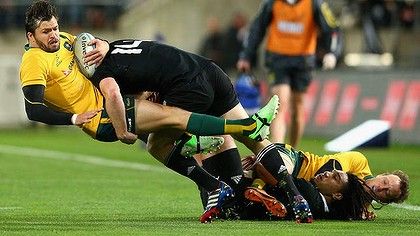How tough are the pro rugby players? This article explores the amount of weight that top-notch rugby players can hoist at the gym.
We also delve into the usual routines for weightlifting among players on the international stage. Plus, we compare their strength with that of NFL players and pro powerlifters.
What’s the Bench Press Weight of Pro Rugby Players?
In the realm of sports, the bench press stands as the ultimate benchmark for gauging strength in the upper body. So, how do Rugby players fare in this regard? The answer is impressively well.
All the figures mentioned here denote the maximum weight a player can lift in a single repetition. It’s the highest amount they can manage just once. This is a rare attempt, hardly ever made during the season.
At the very least, a professional-level player is expected to bench press between 1.3 to 1.5 percent of their own body weight. Many players effortlessly surpass this threshold.
A compilation from a few years ago featuring top professional players showcases a range spanning from 137 kg to 230kg.
This involves lifting some truly substantial weight, especially for athletes engaged in a sport demanding continuous running without pause.
NFL Players
In the world of NFL, recording bench press data focuses on the number of times a player can lift a weight of 102 kg. However, this doesn’t imply that certain NFL players lack impressive achievements in the one-rep maximum lift.
The demands for upper body strength in NFL football differ significantly depending on the player’s position. Linemen require considerably more strength compared to backs or receivers.
For instance, a lineman in the NFL would typically aim for a one-rep maximum bench press ranging between 204 kg and 250 kg.
This figure is somewhat higher than what we observe in rugby, although not by a considerable margin.
It’s also not unexpected that NFL players might achieve slightly higher bench press numbers.
Consider the nature of NFL gameplay, where players need to generate maximum power over short bursts followed by brief periods of rest. This dynamic necessitates and encourages players to prioritise strength in a manner that could be counterproductive in rugby.
How well would rugby players fare in a powerlifting contest?
At least one top-tier rugby player has transitioned to powerlifting successfully after retiring from the sport. Murdoch Alistair, an Australian international, managed to bench press 227 kg (without assistance) in a global competition back in 2014.
You might find it surprising that he held the position of a winger, not a robust forward player.
However, a present-day rugby player wouldn’t make significant progress in a high-level powerlifting competition. The specific type of training required to excel in these lifts would likely hinder their performance on the rugby field.
How much weight do professional rugby players lift in squats?
Although squats may not capture as much attention from the general public, they play a crucial role in developing leg strength.
It’s not unreasonable to expect a front-row player competing at the international level to have the ability to squat 2.5 times their own body weight. This translates to a squat of over 280 kg for a player weighing 115 kg.
This places rugby in the higher tiers of strength requirements across various sports.
One young prop forward
I’m based in Ireland, and a few years back, I started hearing about the impressive weightlifting achievements of a prop playing at the under-20 level. You know how word spreads fast!
The prop in question is Andrew Porter, who has now become a fully-fledged Irish international player. He was actually on track to become a British & Irish Lion, but he had to step back from the tour due to an injury.
Andrew Porter is renowned for being able to lift a maximum weight of 325 kg while squatting. That’s definitely some serious weightlifting!
What about the NFL?
When it comes to an NFL offensive lineman, it’s not uncommon for them to squat weights ranging from 315kg to 360kg.
While these numbers might be a bit higher than what a front-row rugby player typically achieves, it’s worth noting that NFL linemen also tend to have a significantly higher body weight.
In the realm of squats, rugby holds its ground quite well when compared to the strength standards of NFL football.
Powerlifting
Similar to the bench press, powerlifters excel in the squat exercise for much the same reasons. The squat is a fundamental part of the trio of exercises they compete in.
In the world of powerlifting, the highest recorded squat, achieved while wearing a special stretchy squatting suit and knee wraps, stands at a remarkable 595 kg. The record for lifting without any suit or wraps, known as “raw” lifting, reaches 490 kg.
When it comes to sheer squatting strength, it’s hard to find anyone in any sport who truly rivals the top powerlifters.
How frequently do professional rugby players engage in weightlifting?
The frequency of weightlifting for players is influenced by several factors, which encompass:
Whether they are currently in the active playing season or the off-season period.
Their level of effort and the duration spent participating in competitive matches.
The volume of training they undertake during skill-focused sessions.
While building strength holds significant importance for the players, they must strike a balance to ensure that training fatigue doesn’t impede their match performance. Moreover, it’s crucial that their strength training doesn’t hinder their involvement in skill-enhancing sessions.
A typical weightlifting plan for two international players:
Here, we have schedules from two different sources at the international level.
The first one comes from an interview with an England international player (Thomas Waldrom). The second schedule was designed for the Welsh national team.
As you can see, the routines are quite similar. These exceptional players engage in weightlifting sessions three times each week.
| Day | English International | Welsh International |
| Saturday | match day | match day |
| Sunday | Recovery | recovery |
| Monday | upper body weights | lower body weights |
| Tuesday | lower body weights | upper body weights |
| Wednesday | day off | day off |
| Thursday | Weights | only cardio |
| Friday | captain’s run | upper body weights |
It’s essential to understand that there isn’t a strict and unchanging rule.
Professional teams meticulously monitor their players’ workload and biometric factors. If you’re interested in learning more, you can explore our article on GPS trackers in rugby.
Coaches and physiotherapists consistently adapt training based on these metrics.
While specific adjustments vary, certain general patterns emerge when you examine training programs like the ones mentioned above. Let’s delve into a detailed week-long weightlifting schedule.
Importance of recovery days
When Saturday marks match day, Sunday is allocated as a recovery day. During this time, players engage in basic stretching exercises, but not much beyond that.
The bulk of the more intensive training takes place early in the week, typically on Monday and Tuesday. This strategic scheduling ensures that players can exert themselves vigorously while still having ample time before the next match.
Wednesday becomes another recovery day. In fact, it serves as a designated “day off” for professional players. Since they often work during weekends, it’s vital for them to have moments to unwind outside of their professional commitments.
A noticeable trend emerges in the form of decreasing workload as match day draws near. Mondays and Tuesdays often involve double training sessions, a practice that becomes less common as the week progresses.
In one schedule, weights are incorporated on Thursdays, followed by the Captain’s Run on Fridays. The Captain’s Run involves roughly an hour of light cardio training on the match field.
In contrast, the other schedule focuses solely on cardio activities on Thursdays, while reserving some light upper body weightlifting for Fridays.
What type of weight training do professional rugby players engage in?
As observed, the intense weight sessions usually take place on Mondays and Tuesdays. During these days, one session concentrates on strengthening the lower body, while the other targets the upper body.
A robust leg-focused training session involves performing squats and deadlifts.
When it comes to the upper body, the focus shifts to exercises like bench presses, pull-ups, and potentially military presses.
Following the recovery day on Wednesday, players might resume weightlifting. It’s worth noting that some trainers limit weight sessions to two per week during the active season.
A third training session would typically emphasize Olympic lifts, aimed at enhancing explosiveness. This set includes power cleans, snatches, and high pulls.
Regardless of whether it’s Olympic lifts or other weight exercises, the emphasis remains on moving the weights swiftly to develop explosiveness.













